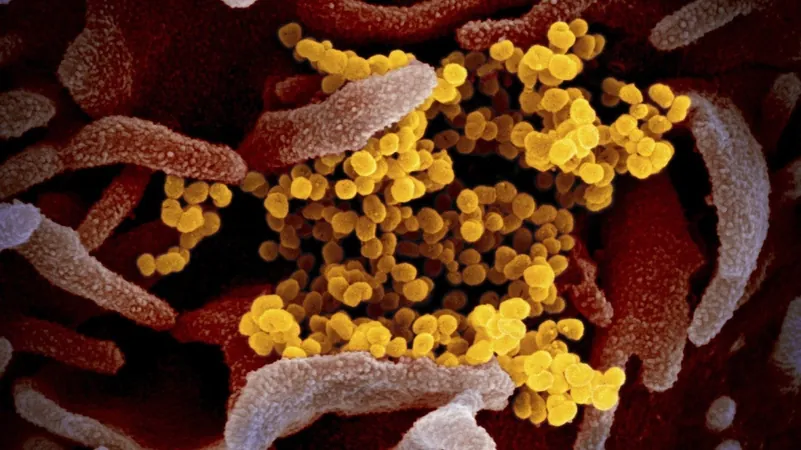
5 Years After COVID-19: What We Know and What Remains a Mystery
2025-01-02
Author: Jacob
Five years ago, the world was shaken by the emergence of COVID-19, a novel virus that first made its presence known in Wuhan, China. This virus marked the beginning of a global pandemic that highlighted significant inequalities in healthcare systems while fundamentally changing perspectives on managing emerging infectious diseases.
As we look back, COVID-19 continues to circulate, but thankfully, a combination of natural immunity and vaccination has led to a decrease in its lethality. Although it is no longer among the top leading causes of death globally, scientists remain vigilant due to the virus's ongoing evolution.
1. The Origins of SARS-CoV-2: A Scientific Mystery
The origin of SARS-CoV-2 remains a tantalizing enigma. Most evidence points to a zoonotic spillover, possibly involving bats and intermediary species such as racoon dogs or civet cats, before reaching humans in the bustling markets of Wuhan. However, the investigation into its origins has been hampered by political tensions, particularly with China, and no definitive conclusion has been reached.
Research labs in Wuhan, known for studying coronaviruses, have also fueled speculation of a laboratory leak — an unproven but widely discussed theory. As time passes, the precise source of this pandemic may stay obscured, leaving scientists and the public alike searching for answers.
2. The Grim Toll: More Than Just Numbers
While official statistics from the World Health Organization (WHO) cite over 7 million COVID-19 related deaths, the actual toll is believed to exceed 20 million globally. Data from the U.S. Centers for Disease Control and Prevention (CDC) shows a consistent average of around 900 deaths per week, predominantly among older adults. With the pandemic still very much a present reality, WHO Director-General Tedros Adhanom Ghebreyesus has warned against viewing COVID-19 as a mere chapter of the past.
3. The Vaccine Breakthrough: A Race Against Time
In a historic scientific achievement, vaccine developers from around the world rushed to create COVID-19 vaccines in record time, saving millions of lives. Teams behind mRNA vaccines like Pfizer and Moderna benefitted from years of prior research that accelerated their development.
More than 13 billion vaccine doses have been administered since 2021, despite the slow rollout in lower-income countries. However, vaccines are not infallible; while they provide strong protection against severe illness, their efficacy against milder infections diminishes after months. To keep up with the virus's mutations, updated boosters are necessary, leading to public concern over the frequency of vaccinations. Researchers are currently exploring next-generation vaccines, such as nasal sprays, that might improve protection against infections.
4. The Evolving Variant Landscape
Like all viruses, SARS-CoV-2 undergoes genetic mutations, leading to new variants. Scientists classify these variants using Greek letters, with notable mutations such as Delta and Omicron drawing significant attention due to their rapid spread and varying severity.
Currently, the prevalent variant, XEC, continues to emerge from the omicron lineage. While it makes up a significant portion of current infections, existing treatments and the latest boosters demonstrate effectiveness against it, offering reassurance amidst ongoing uncertainty.
5. Long COVID: An Ongoing Challenge
For millions worldwide, the battle with COVID-19 extends far beyond the initial infection. Long COVID remains a pressing health issue characterized by lingering symptoms such as fatigue, cognitive impairment, and cardiovascular complications. Interestingly, this condition can affect individuals regardless of the severity of their initial illness.
Research into long COVID is ongoing, with scientific communities studying the potential lingering virus fragments in some patients that could contribute to these prolonged health effects. Yet, despite these studies, many questions about why certain individuals develop long COVID remain unanswered, complicating attempts to devise effective treatments.
As we navigate the continuing impacts of COVID-19, particularly with the emergence of new variants and ongoing health challenges, understanding and adapting to this evolving landscape will be crucial in the years to come. There’s still much to learn about this pandemic and its lessons for future public health responses.



 Brasil (PT)
Brasil (PT)
 Canada (EN)
Canada (EN)
 Chile (ES)
Chile (ES)
 Česko (CS)
Česko (CS)
 대한민국 (KO)
대한민국 (KO)
 España (ES)
España (ES)
 France (FR)
France (FR)
 Hong Kong (EN)
Hong Kong (EN)
 Italia (IT)
Italia (IT)
 日本 (JA)
日本 (JA)
 Magyarország (HU)
Magyarország (HU)
 Norge (NO)
Norge (NO)
 Polska (PL)
Polska (PL)
 Schweiz (DE)
Schweiz (DE)
 Singapore (EN)
Singapore (EN)
 Sverige (SV)
Sverige (SV)
 Suomi (FI)
Suomi (FI)
 Türkiye (TR)
Türkiye (TR)
 الإمارات العربية المتحدة (AR)
الإمارات العربية المتحدة (AR)